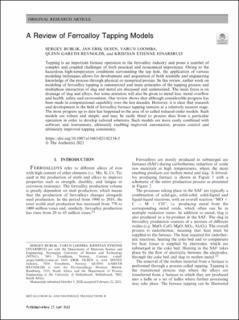| dc.contributor.author | Bublik, Sergey | |
| dc.contributor.author | Olsen, Jan Erik | |
| dc.contributor.author | Loomba, Varun | |
| dc.contributor.author | Reynolds, Quinn Gareth | |
| dc.contributor.author | Einarsrud, Kristian Etienne | |
| dc.date.accessioned | 2021-08-16T11:43:17Z | |
| dc.date.available | 2021-08-16T11:43:17Z | |
| dc.date.created | 2021-04-26T11:11:34Z | |
| dc.date.issued | 2021 | |
| dc.identifier.issn | 1073-5615 | |
| dc.identifier.uri | https://hdl.handle.net/11250/2768002 | |
| dc.description.abstract | Tapping is an important furnace operation in the ferroalloy industry and poses a number of complex and coupled challenges of both practical and economical importance. Owing to the hazardous high-temperature conditions surrounding the tap hole, the application of various modeling techniques allows for development and acquisition of both scientific and engineering knowledge of the process through physical or numerical proxies. In this review, earlier work on modeling of ferroalloy tapping is summarized and main principles of the tapping process and multiphase interaction of slag and metal are discussed and summarized. The main focus is on drainage of slag and alloys, but some attention will also be given to metal loss, metal overflow and health, safety and environment. Our review shows that although considerable progress has been made in computational capability over the last decades, However, it is clear that research and development in the field of ferroalloy furnace tapping remains at a relatively nascent stage. The most progress up to date has happened in the area of so called reduced-order models. Such models are robust and simple, and may be easily fitted to process data from a particular operation in order to develop tailored solutions. Such models are more easily combined with software and instruments, ultimately enabling improved automation, process control and ultimately improved tapping consistency. | en_US |
| dc.language.iso | eng | en_US |
| dc.publisher | Springer | en_US |
| dc.relation.uri | https://link.springer.com/article/10.1007/s11663-021-02134-5 | |
| dc.rights | Navngivelse 4.0 Internasjonal | * |
| dc.rights.uri | http://creativecommons.org/licenses/by/4.0/deed.no | * |
| dc.subject | CFD-beregninger | en_US |
| dc.subject | CFD | en_US |
| dc.subject | Matematisk modellering | en_US |
| dc.subject | Mathematical modelling | en_US |
| dc.title | A Review of Ferroalloy Tapping Models | en_US |
| dc.type | Peer reviewed | en_US |
| dc.type | Journal article | en_US |
| dc.description.version | publishedVersion | en_US |
| dc.rights.holder | Copyright: The Author(s) 2021 | en_US |
| dc.subject.nsi | VDP::Metallurgi: 521 | en_US |
| dc.subject.nsi | VDP::Metallurgy: 521 | en_US |
| dc.source.pagenumber | 2038–2047 | en_US |
| dc.source.volume | 52 | en_US |
| dc.source.journal | Metallurgical and Materials Transactions B | en_US |
| dc.identifier.doi | 10.1007/s11663-021-02134-5 | |
| dc.identifier.cristin | 1906380 | |
| dc.relation.project | Norges forskningsråd: 267621 | en_US |
| cristin.ispublished | true | |
| cristin.fulltext | original | |
| cristin.qualitycode | 2 | |

